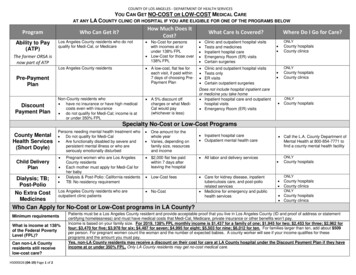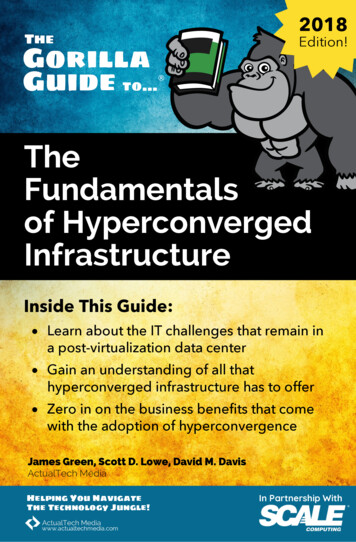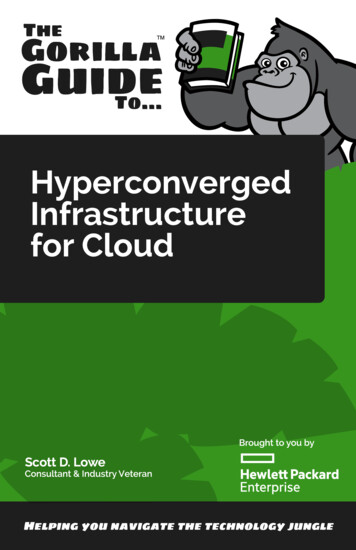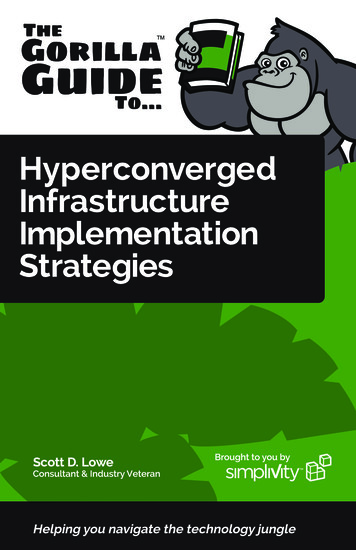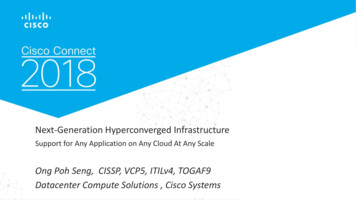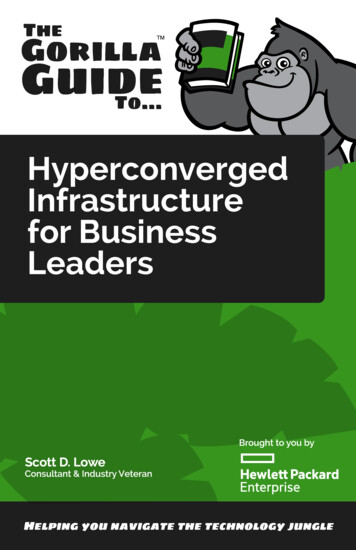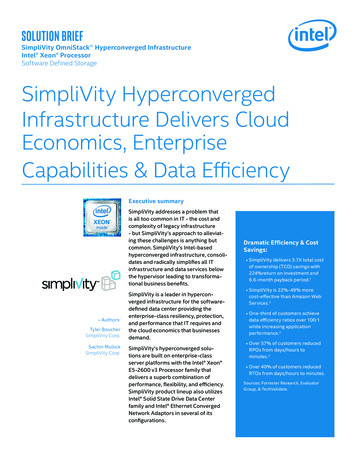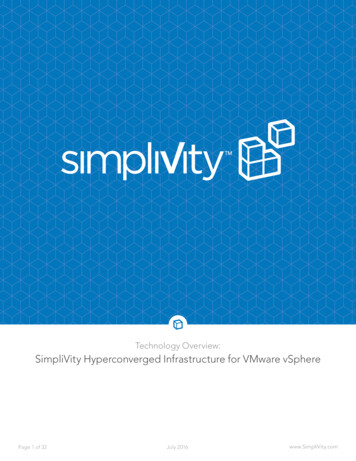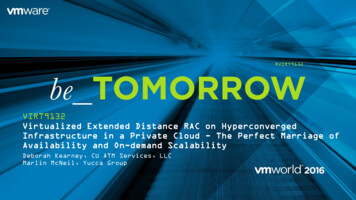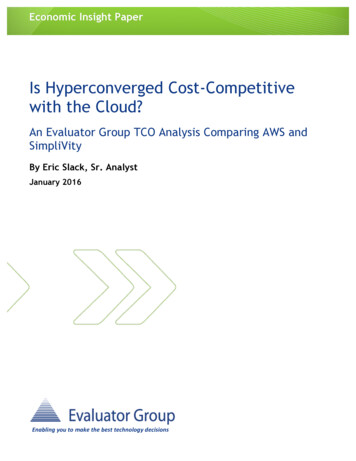
Transcription
Economic Insight PaperIs Hyperconverged Cost-Competitivewith the Cloud?An Evaluator Group TCO Analysis Comparing AWS andSimpliVityBy Eric Slack, Sr. AnalystJanuary 2016Enabling you to make the best technology decisions
Is Hyperconverged Cost-Competitive with the Cloud? 2016 Evaluator Group, Inc. All rights reserved. Reproduction of this publication in any formwithout prior written permission is prohibited.1
Is Hyperconverged Cost-Competitive with the Cloud?2The Cloud, once a radical idea in IT, is now mainstream. Whether it’s email, backup or file sharing, mostconsumers probably use a cloud service or two. Similarly, most IT professionals are familiar with cloudservice providers such as Amazon, Google and Microsoft Azure, and many companies have moved atleast some of their information technology processes into the cloud. In fact, the cloud has become sopopular it’s easy to assume that running IT applications on-premises is not cost competitive with acloud-based service. In this report Evaluator Group will test the validity of that assumption with a TCO(Total Cost of Ownership) model analyzing a hyperconverged appliance solution from SimpliVity and acomparable cloud service from Amazon Web Services (AWS).Total Cost of OwnershipTCO is a calculation designed to expose the true costs associated with a specific system or piece ofcapital equipment, since the “sticker price” often understates the actual cost of implementationincurred by the business. This is especially true for IT systems, given the level of complexity of traditionalinfrastructures.Many of the costs associated with IT equipment can be overlooked, including things like design andevaluation, installation, integration with existing systems and training. In addition to capital expenses(CAPEX), operating expenses (OPEX) need to be included in TCO as well, especially personnel oradministrative overhead required to keep the system running and to expand and upgrade it throughouta given lifespan.TCO models are often used to support capital purchases, but also to help managers make strategicdecisions, such as whether to run a certain business process in-house or to out-source it. IT processesare good candidates for this “build or buy” decision since most applications can be run on servers in apublic cloud just like they can in the company data center.The Cloud AssumptionEveryone from CIOs to consumers hears about the benefits of the cloud on a regular basis. Trulyubiquitous, it’s easy to assume that the cloud is fundamentally less expensive than running on-siteinfrastructure. Part of this thinking may be due to the economics of the “web-scale” data centers thatcloud providers run, but probably more to the complexity of setting up and running traditional servers,storage and networking. Many of the companies using cloud services have no doubt run TCOcalculations of their own and at one point found it to be the right decision. And with the trend towardsleaner staffing and lower levels of expertise in IT organizations, the “cloud assumption” would seem tobe further supported. But this assumption may no longer be accurate. 2016 Evaluator Group, Inc. All rights reserved. Reproduction of this publication in any formwithout prior written permission is prohibited.
Is Hyperconverged Cost-Competitive with the Cloud?3The cloud assumption has historically been based on a comparison with legacy infrastructures thatconsist of separate systems for each IT function, such as compute and storage, even data protection.Given the cost realities, many companies found the idea of running applications in the cloud veryappealing and the option to pay for them on a monthly basis certainly simplified the decision process.But what about hyperconverged systems?Hyperconverged InfrastructuresThese solutions combine storage and compute components with a hypervisor and managementsoftware to create a comprehensive compute solution. Some vendors go even further to includefeatures such as data protection and built-in data efficiency. Hyperconverged systems appeal tocompanies for many of the same reasons the cloud does. They are easy to set up and run and easy touse, providing operational agility and greatly simplifying the overall infrastructure, compared withtraditional IT solutions.Hyperconverged infrastructures change the traditional TCO calculations that have been used to justifycloud decisions. Specifically:§Hyperconvergence greatly simplifies the design process§“Plug and play” format means very little implementation§Internal integration with hypervisor management lowers operating complexity§VM-level focus simplifies storage-related tasks in virtualization environments§Scale-out architecture is designed for cost-effective, incremental growthWhile the trend in IT organizations is toward lower staffing and expertise levels, the emergence ofhyperconverged infrastructures fundamentally changes the TCO economics. This begs the question, “Isthe cloud assumption still valid?” For this reason, Evaluator Group compiled the following informationon the total costs associated with SimpliVity’s hyperconverged infrastructure and a comparableinfrastructure running in Amazon Web Services.Hyperconverged vs. Cloud TCO ModelFor this comparison we used an OmniCube CN-3400 hyperconverged appliance and Amazon’s EC2 cloudcompute service. In addition to OmniCube SimpliVity offers the “OmniStack” line of products, with 2016 Evaluator Group, Inc. All rights reserved. Reproduction of this publication in any formwithout prior written permission is prohibited.
Is Hyperconverged Cost-Competitive with the Cloud?4partners such as Cisco and Lenovo, which provide similar features and benefits to the OmniCubesystems evaluated in this report. To make these systems highly available, we chose an N 1 configurationfor the OmniCube cluster, with “N” being the number of active SimpliVity “nodes” (each supporting 103VMs), and one redundant node. It should be noted that Amazon offers a 99.9% availability for the EC2service used in this comparison, which is a significantly lower level of availability than what can beachieved with the OmniCube N 1 configuration.The baseline configuration in this model was a three-node cluster, supporting 206 VMs (2 data nodes x103 VMs/node), as shown in Figure 1. Costs for VM counts of 309, 412 and 515 are also calculated in themodel corresponding to four-, five- and six-node SimpliVity clusters. However, this could certainly beextended since upgrading these hyperconverged systems with new nodes is easy to do and doesn’trequire downtime or data migration. And, as shown below, the economics of these systems get strongeras they are scaled.We assumed a 3-year period for the infrastructure, a typical IT capital equipment lifespan, and all onetime costs were calculated based on a 36-month simple amortization. Leasing is also an option for manycompanies, allowing them to turn the capital expenditure into a monthly expense, although it’s notincluded in this model.For the baseline comparison with the SimpliVity solution we chose Amazon’s “3-year All Upfront,Reserved” pricing. In the model, the substantial upfront fee of this option is amortized into 36 monthlyincrements, similar to the hardware costs in the SimpliVity hyperconverged infrastructure. It should benoted that this is the lowest cost option for AWS. Amazon also offers 1-year and “on-demand” options,which are significantly more expensive on a per-VM basis (Figure 1).Amazon Web ServicesAWS offers Elastic Compute EC2 web services on a per-VM basis, so we priced configurations starting at206 VM instances and then in increments of 103 VMs. The following list shows the specific componentcharges for the baseline 206-VM AWS infrastructure, based on a configuration created on the AWSwebsite in January 2016.Amazon EC2 Service (US-East)§Compute – “M3.medium” instance, 1 vCPU, 3.7GB memory, 100% utilized§EBS Volumes – For each instance, 100GB of “General Purpose SSD” storage was chosen§EBS IOPS – for each instance, we chose 300 IOPS for this 100GB of storage§EBS Snapshots – for each instance, a 10% daily change with 30-day retention was chosen 2016 Evaluator Group, Inc. All rights reserved. Reproduction of this publication in any formwithout prior written permission is prohibited.
Is Hyperconverged Cost-Competitive with the Cloud?§AWS Data Transfer In – we estimated 0.5TB of data per month, per 103 VMs§AWS Data Transfer Out – we estimated 4.5 TB of data per month, per 103 VMs§AWS Support – we chose Business Support for all AWS services5The total monthly cost for this 206-VM infrastructure was 12,860.58 or 62.46 per VM. (Figure 1)SimpliVity OmniCubeThe OmniCube calculations include CAPEX costs for hardware, software and maintenance, plus OPEXcosts associated with data center overhead and administration. The following list shows these specificcomponents of the total cost of a three-node cluster. OmniCube acquisition price – the list price, less a standard discount, for three SimpliVity CN-3400nodes required for an N 1 configuration. OmniCube maintenance – the 3-year maintenance cost for these nodes vSphere licenses – the 3-year cost of a hypervisor license for each 2-CPU node, assuming a 10%discount off list vSphere support – the cost of hypervisor support for licenses required for a given configuration Power, cooling and rack space – the 3-year data center facility cost assuming 100 per node, permonthAdministrative SupportPerhaps the largest component of total operating expenses is the cost of administering theinfrastructure. For this model, we used the following calculation for personnel required to run eachOmniCube node:Hourly cost of fully burdened employee ( 150,000 per year 75/hour) * hours required tomanage each node (1 hour per week) * 52 weeks * 3 years.The total monthly cost for this SimpliVity OmniCube cluster is 12,292.02 or 59.67 per VM, roughly 4%less than the comparable AWS price. The chart in Figure 1 shows the 3-year costs for the SimpliVitysolution and the AWS infrastructure described above. It also shows the costs for AWS pricing based onshorter timeframes which, again, are significantly higher. 2016 Evaluator Group, Inc. All rights reserved. Reproduction of this publication in any formwithout prior written permission is prohibited.
Is Hyperconverged Cost-Competitive with the Cloud?6Figure 1Scaling the InfrastructureExpansion of this hyperconverged infrastructure involves adding nodes to the cluster. Given the N 1configuration, each additional node increases the VM count by 103, effectively distributing the cost ofthe redundant “ 1” node across more data nodes. This improves the economics of the system. Incomparison, the AWS infrastructure is essentially unchanged on a per-VM basis.The graph in Figure 2 shows the widening differential between the monthly cost per VM on SimpliVityOmniCube and AWS, as the infrastructure scales from 206 to 515 VMs (two to five nodes). Thisdifferential would fluctuate somewhat as the number of redundant nodes increases, but the SimpliVitysystem is still less expensive than the cloud solution at all levels of scale. 2016 Evaluator Group, Inc. All rights reserved. Reproduction of this publication in any formwithout prior written permission is prohibited.
Is Hyperconverged Cost-Competitive with the Cloud?7Figure 2Why Hyperconverged TCOs are LowerAs mentioned above, hyperconverged solutions, like SimpliVity, change the TCO calculations historicallyused in IT decision making. By simplifying the physical infrastructure, using non-proprietary hardwareand reducing or eliminating many of the tasks typically associated with implementing hardware andsoftware they lower total costs, both capital expenditures and operating expenses.Capital ExpendituresHyperconverged systems combine storage and server functions, potentially reducing the overall cost byreducing the number of physical systems that must be purchased. They also leverage the economics ofindustry-standard, “commodity” hardware to further push acquisition costs down compared withproprietary storage and compute systems.Systems like SimpliVity eliminate the cost and complexity of implementing a complete infrastructure forvirtualized workloads using open systems components. The “design” process consists of selectingenough nodes to support the expected VM count and configuring those nodes to fit the expectedworkloads. There’s no long, involved installation phase; in fact, most hyperconverged appliance 2016 Evaluator Group, Inc. All rights reserved. Reproduction of this publication in any formwithout prior written permission is prohibited.
Is Hyperconverged Cost-Competitive with the Cloud?8solutions can be deployed in less than an hour with very little need to “integrate” the cluster withexisting systems. Expanding the system is simple as well, just add nodes to provide the requiredresources and the cluster re-balances itself.As a comprehensive solution, storage services and management software, and in some cases built-indata protection, come pre-installed as part of the package. These services typically include storageefficiency features such as inline deduplication, which when integrated into the base product canprovide significant reduction in the amount of storage consumed. Related to efficiency is the way scaleout topologies can expand incrementally, improving capacity utilization and further reducing CAPEX.Operating ExpensesManagement of the hyperconverged cluster is usually integrated into the hypervisor, allowing anadministrator to handle more VMs than is possible with a traditional shared storage infrastructure.Hyperconverged solutions, like SimpliVity, are designed with VM-centric management, the ability toprovision storage and create management policies for each VM rather than for each storage volume.This further simplifies the day-to-day “care and feeding” of the system making the infrastructuremanageable by employees without specific storage skills.When more resources are required many hyperconverged systems support non-disruptive expansion,eliminating what has typically been a complex process. All these factors add up to an infrastructure thatcan be managed by fewer people, and those with less IT expertise. This is one of the most significantdifferences between the TCO of hyperconverged systems and a traditional infrastructure of separateelements for compute, storage and data protection.Cumulative CostsAs mentioned earlier, TCO models are also used for strategic decisions, such as whether to put new orexisting IT infrastructure into the cloud. Part of this strategy discussion involves the long-term,cumulative costs of different options. Sometimes expressing costs incrementally, on a per-VM basis as inthis model, can minimize the impact of each alternative. In these instances, a cumulative cost calculationis often useful, such as the graph in Figure 3.This graph shows the AWS options are 1.14M to 1.7M, when the cost of 515 VMs are added for theentire 36-month period. However, the SimpliVity solution is only 885K, 22% to 49% less when totaledover that same timeframe. What would seem to be a modest per-VM cost differential can extrapolateout to hundreds of thousands of dollars in a few years. 2016 Evaluator Group, Inc. All rights reserved. Reproduction of this publication in any formwithout prior written permission is prohibited.
Is Hyperconverged Cost-Competitive with the Cloud?9SimpliVity Total Cost 22% to 49% Less than AWS over 3 YearsCost of 515VMs overthree years- 1.74 MAWS- 1.14 M- 885 K OmniCubeFigure 3Summary / ConclusionThe Cloud, once a novel idea in IT, is now an accepted, mainstream alternative. This fact has contributedto the assumption that the cloud must be less expensive than an in-house infrastructure. For manycompanies the justification for choosing the cloud has been the high cost of implementing traditionalservers and storage components, and operating them over time. Often, a Total Cost of Ownershipcalculation has been used to make this comparison and support the “cloud assumption”.In this report Evaluator Group shows that assumption is no longer valid, based on a TCO model thatcompares SimpliVity hyperconverged infrastructure with a solution from AWS. Due to theircomprehensive, low-cost hardware architectures and advanced efficiency and management features,hyperconverged infrastructure can cost significantly less than a comparable cloud solution. And, thatcost differential gets better with larger systems and longer timeframes. 2016 Evaluator Group, Inc. All rights reserved. Reproduction of this publication in any formwithout prior written permission is prohibited.
Is Hyperconverged Cost-Competitive with the Cloud?10About SimpliVitySimpliVity hyperconverged infrastructure provides a scalable, modular, 2U building block ofx86 resources that offers all the functionality of traditional IT infrastructure— in one device.It assimilates storage, compute, hypervisor, real-time deduplication, compression andoptimization into a single appliance, along with comprehensive data management, dataprotection, and disaster recovery capabilities.Designed to work with any hypervisor or industry-standard x86 server platform, theSimpliVity solution provides a single, shared resource pool across the entire IT stack,eliminating point products and “siloed” IT architectures. The solution is distinguished fromother hyperconverged products by three attributes: accelerated data efficiency, built-indata protection and global unified management.Inline deduplication, compression and optimization are applied to all data at inception,reducing resource consumption (storage and CPU) while increasing applicationperformance. SimpliVity systems include native data protection functionality, whileeliminating the need for special-purpose backup and recovery hardware or software. VMcentric management enables system administrators to manage all resources and workloadscentrally, using familiar interfaces such as VMware vCenter.About Evaluator GroupEvaluator Group Inc. is dedicated to helping IT professionals and vendors create and implement strategies that make the most of the valueof their storage and digital information. Evaluator Group services deliver in-depth, unbiased analysis on storage architectures,infrastructures and management for IT professionals. Since 1997 Evaluator Group has provided services for thousands of end users andvendor professionals through product and market evaluations, competitive analysis and education. www.evaluatorgroup.com Follow uson Twitter @evaluator groupCopyright 2016 Evaluator Group, Inc. All rights reserved.No part of this publication may be reproduced or transmitted in any form or by any means, electronic or mechanical, including photocopying and recording,or stored in a database or retrieval system for any purpose without the express written consent of Evaluator Group Inc. The information contained in thisdocument is subject to change without notice. Evaluator Group assumes no responsibility for errors or omissions. Evaluator Group makes no expressed orimplied warranties in this document relating to the use or operation of the products described herein. In no event shall Evaluator Group be liable for anyindirect, special, inconsequential or incidental damages arising out of or associated with any aspect of this publication, even if advised of the possibility ofsuch damages. The Evaluator Series is a trademark of Evaluator Group, Inc. All other trademarks are the property of their respective companies. 2016 Evaluator Group, Inc. All rights reserved. Reproduction of this publication in any formwithout prior written permission is prohibited.
OmniCube node: Hourly cost of fully burdened employee ( 150,000 per year 75/hour) * hours required to manage each node (1 hour per week) * 52 weeks * 3 years. The total monthly cost for this SimpliVity OmniCube cluster is 12,292.02 or 59.67 per VM, roughly 4% less than the comparable AWS price.


